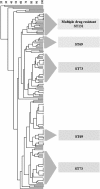High metabolic potential may contribute to the success of ST131 uropathogenic Escherichia coli
- PMID: 22814460
- PMCID: PMC3457456
- DOI: 10.1128/JCM.01423-12
High metabolic potential may contribute to the success of ST131 uropathogenic Escherichia coli
Abstract
Uropathogenic Escherichia coli (UPEC) is the predominant cause of urinary tract infection in both hospital and community settings. The recent emergence of multidrug-resistant clones like the O25b:H4-ST131 lineage represents a significant threat to health, and numerous studies have explored the virulence potential of these organisms. Members of the ST131 clone have been described as having variable carriage of key virulence factors, and it has been suggested that additional unidentified factors contribute to virulence. Here we demonstrated that ST131 isolates have high metabolic potential and biochemical profiles that distinguish them from isolates of many other sequence types (STs). A collection of 300 UPEC isolates recovered in 2007 and 2009 in the Northwest region of England were subjected to metabolic profiling using the Vitek2 Advanced Expert System (AES). Of the 47 tests carried out, 30 gave a positive result with at least one of the 300 isolates examined. ST131 isolates demonstrated significant association with eight tests, including those for peptidase, decarboxylase, and alkalinization activity. Metabolic activity also correlated with antibiotic susceptibility profiles, with resistant organisms displaying the highest metabolic potential. This is the first comprehensive study of metabolic potential in the ST131 lineage, and we suggest that high metabolic potential may have contributed to the fitness of members of the ST131 clone, which are able to exploit the available nutrients in both the intestinal and urinary tract environments.
Figures



References
-
- Alteri CJ, Smith SN, Mobley HL. 2009. Fitness of Escherichia coli during urinary tract infection requires gluconeogenesis and the TCA cycle. PLoS Pathog. 5:e1000448 doi:10.1371/journal.ppat.1000448 - DOI - PMC - PubMed
-
- Brauner A, et al. 1987. The use of biochemical markers, serotype and fimbriation in the detection of Escherichia coli clones. J. Gen. Microbiol. 133:2825–2834 - PubMed
-
- Ewing W, Edwards PR. 1986. The genus Escherichia, p 67–107 In Identification of Enterobacteriacae, 4th ed Burgess, Minneapolis, MN
Publication types
MeSH terms
Substances
LinkOut - more resources
Full Text Sources
Medical

